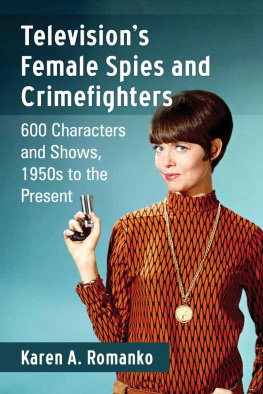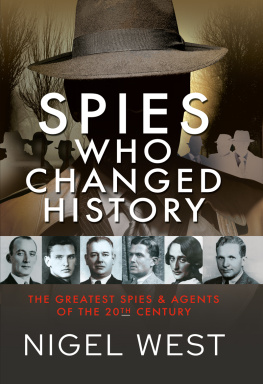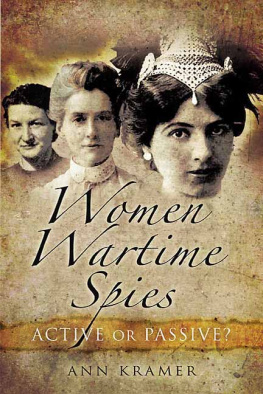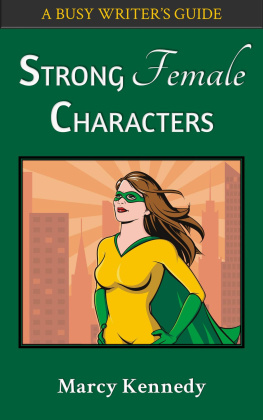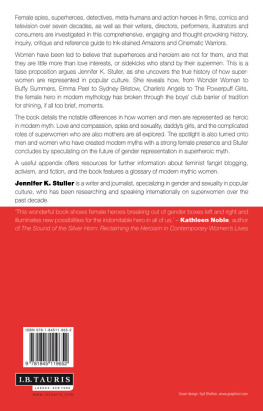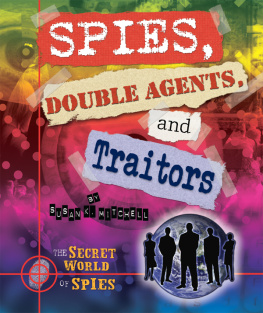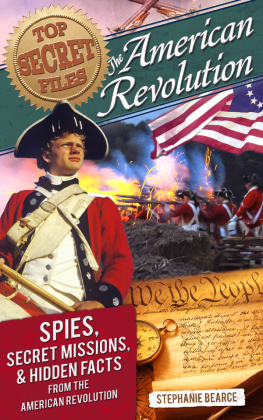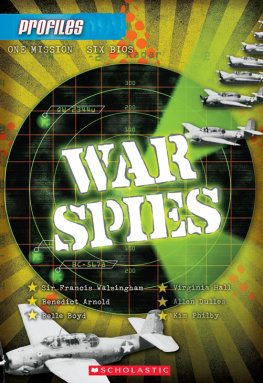Televisions Female Spies and Crimefighters
600 Characters and Shows, 1950s to the Present
Karen A. Romanko

McFarland & Company, Inc., Publishers
Jefferson, North Carolina
LIBRARY OF CONGRESS CATALOGUING DATA ARE AVAILABLE
BRITISH LIBRARY CATALOGUING DATA ARE AVAILABLE
e-ISBN: 978-1-4766-2415-0
2016 Karen A. Romanko. All rights reserved
No part of this book may be reproduced or transmitted in any form or by any means, electronic or mechanical, including photocopying or recording, or by any information storage and retrieval system, without permission in writing from the publisher.
Front cover image of Barbara Feldon from Get Smart, NBC 19651970 (Photofest)
McFarland & Company, Inc., Publishers
Box 611, Jefferson, North Carolina 28640
www.mcfarlandpub.com
For TVs female trailblazers
and for Bob, my partner in crime
Table of Contents
Preface: Whats in This Book
From Emma Peel with her kinky boots to Amanda King and her poppy seed cake, from Julie Barnes with her hippie pad to Honey West and her pet ocelot, televisions female spies and crimefighters leave an indelible impression, but there hasnt been a reference work devoted to them until now.
Televisions Female Spies and Crimefighters: 600 Characters and Shows, 1950s to the Present covers television series which feature female spies, private investigators, amateur sleuths, police detectives, federal agents and crime-fighting superheroes as lead or noteworthy characters. The focus is on live-action shows which aired in the United States on network TV, cable, or in syndication, wherever produced, from televisions inception through August 2014. For series which aired fewer than 25 episodes in the U.S., the coverage is selective, emphasizing shows with distinctive female lead characters.
Every show in the book receives at least one entry under series title, arranged alphabetically, and the listing includes the range of years in production, number of episodes, and country of origin. Under the title is a listing of series credits, including creator, production company, original U.S. network, and main cast, followed by a synopsis of the series, covering notable plot points, important or fun facts, and sometimes critical commentary. Among those plot points, facts, and critical comments, the occasional spoiler creeps in, so readers using the book as a viewers guide should consider this a universal spoiler alert.
Female characters whose names are highlighted in bold within the title entry also have entries under their own names (last name first) to provide more in-depth coverage, while female characters not receiving separate entries are listed with a cross-reference to the series title. Thus, readers are able to reference characters by either series title or the characters name.
For the series Cold Case, for example, the main entry is under:
Cold Case(20032010, 156 episodes, USA)
An entry on Cold Case lead character Lilly Rush, a homicide detective in the series, adds valuable detail, including descriptions of representative episodes, under:
Rush, Lilly (Cold Case)
Cold Case detective Kat Miller, a supporting character, is mentioned within the series entry, so she receives a brief description with a cross-reference:
Miller, Kat (Cold Case)
Member of a Philadelphia homicide team specializing in unsolved cases. See: Cold Case(20032010, 156 episodes, USA)
Cross-references are also provided for alternate series titles, such as:
The New Adventures of Wonder Woman
See: Wonder Woman(19751979, 59 episodes, USA)
Entries which begin with numbers are alphabetized as though the numbers are spelled out. The following entry for 21 Jump Street, for example, is found under T, as though it were Twenty-one Jump Street:
21 Jump Street(19871991, 103 episodes, USA)
Covering 350 female spies and crimefighters who have appeared in more than 250 television series since the 1950s, this is a comprehensive reference to an important but overlooked aspect of television history.
Introduction: A Brief History of Female Spies and Crimefighters on Television
Honey. A peculiarly sweet name for a person who works in the hardboiled profession of private detective, but when Honey West hit the small screen in 1965, Honey was the perfect name to signal that women were about to step out from behind the secretarys desk to become detectives in their own right. Honey West was the head of her own agency and ahead of her time. She was a woman in a traditionally male profession, but she made private investigating womens work, using every tool at her disposalintelligence, bravery, martial arts skills, and, yes, sex appealto solve mysteries and bring bad guys to justice. The actress who portrayed her, Anne Francis, was breaking new ground as well, starring as the lead in an action/crime series, a province usually reserved for men. Yes, the times they were a-changin, but the revolution would come slowly. Honey West lasted only one season.
Female detectives werent exactly foreign to television prior to Honey West, but most were amateur sleuths and even then usually appended to a husband as part of an adorable sleuthing couple. Connie Conway (Lynn Bari) as The Detectives Wife (1950), Louise Baker (Randy Stuart) as the partner in life and intrigue of Biff Baker, U.S.A. (19521953), Pamela North (Barbara Britton), the distaff half of Mr. & Mrs. North (19521954), and Nora Charles (Phyllis Kirk), wife of The Thin Man (19571959), were all detectives by marriage, and often waited for crime to find them, usually with comic results. Pamela North, with her keen eye for detail and ability to read people, stands out as a true detective here, perhaps because the source novels for Mr. & Mrs. North were co-authored by Frances Lockridge, who contributed a womans viewpoint to her writing partnership with husband Richard.
One exception to the dearth of professional female detectives on TV during the 1950s was Casey Jones in Decoy: Police Woman (19571958). Portrayed by Beverly Garland, Casey tackled undercover assignments for the New York City police department, posing as a blackmailer, nurse, or gun moll to catch crooks in the act. Decoy: Police Woman lasted just one season and appeared only in syndication, but gave a hint of better things to come for female detectives as lead characters on television.
Other than Jones and the adorable wives, women in detective shows of the 50s were usually secretaries, receptionists, girlfriends, or some combination thereof. One standout among the clerical set was Sam (Mary Tyler Moore and later Roxane Brooks, both uncredited at the time), an answering-service operator for private eye Richard Diamond (David Janssen) in Richard Diamond, Private Detective (19571960). Sam called Mr. D. with important messages, often catching him in the nick of time to avert danger and possible bodily harm at the hands of assorted bad guys. She was shown only from the waist down to emphasize her shapely legs, setting the bar low for working women in crime series, but it would be raised substantially just one year later with international help.
As the 60s dawned, our progressive cousins across the pond set a high example for female derring-do with both Dr. Cathy Gale and later Mrs. Emma Peel on

